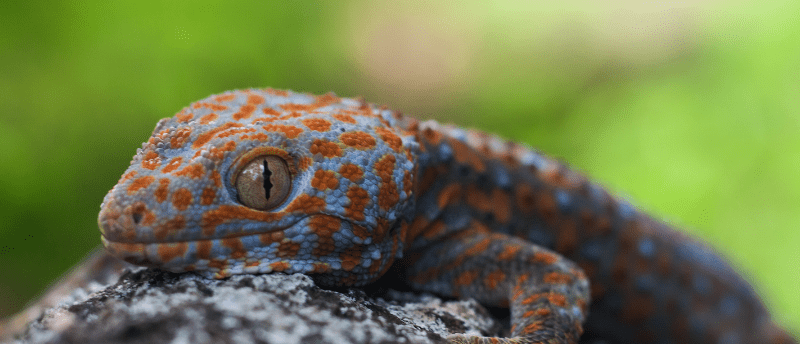The smelly smell of self-recognition?

Academics have demonstrated that geckos can differentiate their own smell from the skin and feces of other geckos. This discovery casts a new light on the complexity of reptile social connections.
The recognition of the self via environmental stimuli is a mark of intelligence for a species. The most notable experiment of self-recognition is the mirror self-recognition test. Zoologists and animal behaviorists can determine self-awareness in animals if an animal can comprehend that, when presented with a mirror, it is gazing at a reflection of itself. Animals deemed to be self-aware include orcas, bottlenose dolphins, most great apes, Asian elephants and certain species of fish.
However, the ability of an animal to recognize itself in the mirror only paints the most anthropomorphic picture of self-awareness. Our eyes are the key to our navigation of the external world. Other species are less reliant on sight and utilize their powerful sense of hearing or smelling to map their environments. If a species uses smells to mark territory and to find mates or rivals, then it is not far-fetched that they would use smell for self–other recognition.
This was the hypothesis probed by academics from the University of Bern (Switzerland) in a new study centered around tokay geckos. It is well known that geckos, along with most reptiles, use their tongues to detect chemical signaling from other geckos, implying a smelly social network the complexity of which we do not fully understand. “Lizards and reptiles are generally seen as unsocial primitive animals,” said co-author Brigit Szabo, explaining the rationale for the study. “We must recognize that reptiles are more social and intelligent than we thought.”
 Communication is key for dolphins completing cooperative tasks
Communication is key for dolphins completing cooperative tasks
Researchers have demonstrated that dolphins in captivity are affected by artificial high-volume noises, which impacts their ability to communicate effectively.
In the study, captive male and female tokay geckos in their home enclosure were randomly presented with swabs containing either tap water, peppermint oil, a sample of their own scent or a sample of the scent of an unfamiliar gecko of the same sex. The researchers monitored the responses the geckos presented for each swab. The primary behavior they were looking for was tongue flicks. Typically, the geckos would first flick their tongues toward the swab, then, flick their tongue down to compare with the smell of their own enclosure.
For the female geckos, the team observed that, when presented with an unfamiliar smell, the geckos would compare the scent with the smell of their enclosure more frequently than when presented with their own scent. “The geckos have to compare more frequently when confronted with the odor of another gecko, compared to their own order,” Szabo explained. “This indicates that they know their own odor.”
The researchers acknowledge that further study is needed to fully confirm that geckos possess self–other recognition. There are also several other factors for them to probe, including the mechanism of mate and kin recognition.
Co-author Eva Ringler postulated that understanding how geckos and reptiles communicate may provide insight into the evolution of social structures. “Reptiles, and especially geckos, are ideally suitable for investigating fundamental questions about the evolution of sociality. Within geckos, we can find a vast range of structures and habitats. This allows us to investigate the interrelationship of cognition, communication and social living within a small taxonomic group – and make comparisons between these and other, more distantly related groups of animals, such as mammals and birds.”